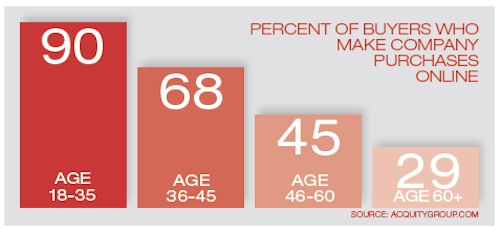Four Reasons to Take Your Company Digital
eCommerce isn’t just another channel, it’s the future of business.
by Linda Taddonio
 Today’s eCommerce is radically different from yesterday’s digital storefront. It has quickly become a multi-faceted, increasingly powerful spectrum of tools and technologies that organizations must have to remain competitive and relevant in today’s challenging environment.
Today’s eCommerce is radically different from yesterday’s digital storefront. It has quickly become a multi-faceted, increasingly powerful spectrum of tools and technologies that organizations must have to remain competitive and relevant in today’s challenging environment.
The business-to-business (B2B) eCommerce market is expected to quickly outpace that of the business-to-consumer (B2C) market. Per industry analyst firm Forrester, by the end of this year, the B2B eCommerce market is expected to reach $559 billion.
eCommerce isn’t just another “channel,” it’s the future of your business. There are so many reasons why companies need to get in the eCommerce game, but in the interest of time and space, I’ve noted just a few:
1. New Competitors Now Arriving (Daily)
The eCommerce landscape is changing rapidly. Online powerhouses Google and
Amazon recently entered the B2B eCommerce space, particularly intimidating to
manufacturers and distributors serving the same vertical markets. With the advent of AmazonSupply.com and Google Shopping for Suppliers, organizations
must make strategic moves now to ensure they can effectively compete online.
If you don’t have an active eCommerce strategy in place or if eCommerce is not a critical piece of your current ongoing business growth, then a portion of your core business — at least those customers who buy from you based on price and inventory availability — is at risk.
2. The Future Belongs to the Young
In the next five to ten years, Millennials will completely dominate the workforce the way that Baby Boomers once did. Growing ranks of Millennials in the corporate purchasing ranks has significant implications for your business.
Whereas older generations preferred face-to-face contact or business dealings over the phone, statistics confirm younger workers prefer to communicate using technology. Given their immersion into the 24/7 nature of Internet communications as a whole, your firm must expect to serve the needs of Millennials all hours of the day.
Recent research indicates suppliers’ websites often aren’t capable of handling the evolving demands of younger B2B buyers. It revealed that 90 percent of B2B buyers age 18-35 now make company purchases online, compared with 45 percent of those age 45-60 and 29 percent of those age 60+. Additionally, 45 percent of survey respondents used Amazon Supply to make a purchase in the last year, and 40 percent of respondents make frequent purchases from Amazon Supply.

3. New Math
eCommerce can be the catalyst for more favorable economics. By implementing online B2B processes, businesses can lower overhead by moving offline customers to
self-serve, online environments. Secure online payments also reduce paperwork and collection activity.
Imagine if you could wring five to ten percent or more of the cost out of the equation for each order processed? And imagine if, as a result you could reallocate the time and energy of your staff to create relationships with five to ten new customers? This is the power of B2B eCommerce.
On the demand side of the equation, providing digital access accelerates your customers’ access to the products, services and benefits you provide and, if done well, will lift your revenue.
4. Data to Drive Better Sales Outcomes
The data from eCommerce is quantifiable, enabling organizations to acquire vital data about customer purchasing behavior. This data, coupled with online reporting and analytics, allows the organization to better identify buying patterns as well as increasingly intelligent cross-sell and related products to promote to specific target audiences, increasing the average amount of each sale.
Better information about future demand through B2B eCommerce may give you key insight to improve demand forecasts, which can be used to tweak your production or purchasing decisions to better match demand.
|
Distributors and manufacturers still have an edge over Amazon and Google through networks and established B2B customer relationships, product knowledge and expertise. |
You can reengineer your business for successful B2B sales in the digital era. Customers don’t expect B2B organizations to be the next Amazon or Google, but they do have expectations for a feature-rich, dynamic and interactive B2B engagement.
The first step for organizations is to evaluate their eCommerce strategy and begin to address the emerging online business requirements of their customers. Once the business requirements are identified, organizations are ready to play to their strengths.
And remember, this is a journey, not a project. Distributors and manufacturers still have an edge over Amazon and Google through networks and established B2B customer relationships, product knowledge and expertise — plus a considerably wider product assortment offered within the vertical space — and both of these can be extremely advantageous. AmazonSupply.com and Google Shopping for Suppliers will compete on price and availability for their product offerings, but the value wholesalers, distributors and manufacturers provide in personal relationships and resources can make up for it — especially if they can price match when it matters.
But you can’t win if you don’t play. That’s why I urge you to take control of your online destiny today and reengineer your business for success in the digital era. CS
Linda Taddonio is co-founder and chief eCommerce strategy officer of Insite Software, which provides B2B and B2C eCommerce technology and internationally enabled shipping solutions, serving more than 950 customers worldwide. She is a CPA, has a B.A. in Music and a M.A. in Accounting from the University of Iowa. Reach her at 866-746-0377 or visit www.insitesoft.com.
















